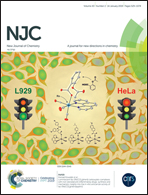Microwave-assisted fabrication of multicolor photoluminescent carbon dots as a ratiometric fluorescence sensor for iron ions†
Abstract
Herein, we present a facile approach for the preparation of multicolor emissive carbon dots (M-CDs) within 20 min by microwave irradiation. M-CDs could emit tunable fluorescence emissions from violet to red without clearly compromising the fluorescence intensities. Moreover, M-CDs showed excellent solubility and stability in both water and common organic solvents. Their optical properties and structural characterization were investigated in detail. The continuously tunable multicolor emissions were considered to originate from surface C![[double bond, length as m-dash]](https://www.rsc.org/images/entities/char_e001.gif) N-related groups. For the first time, M-CDs were utilized as a sensitive and selective ratiometric fluorescence sensor for label-free detection of Fe3+. The fluorescent intensity ratio of dual fluorescence bands (F368/F605) decreased linearly against the concentration of Fe3+ with a detection limit of 10 nM. Excellent results were also obtained in real water sample analysis with recoveries ranging from 91% to 99%. The M-CDs demonstrated amphibious performance and unique multicolor emissions, which could offer them more opportunities in advanced applications such as multicolor displays, multimodal sensing and many other fields.
N-related groups. For the first time, M-CDs were utilized as a sensitive and selective ratiometric fluorescence sensor for label-free detection of Fe3+. The fluorescent intensity ratio of dual fluorescence bands (F368/F605) decreased linearly against the concentration of Fe3+ with a detection limit of 10 nM. Excellent results were also obtained in real water sample analysis with recoveries ranging from 91% to 99%. The M-CDs demonstrated amphibious performance and unique multicolor emissions, which could offer them more opportunities in advanced applications such as multicolor displays, multimodal sensing and many other fields.



 Please wait while we load your content...
Please wait while we load your content...